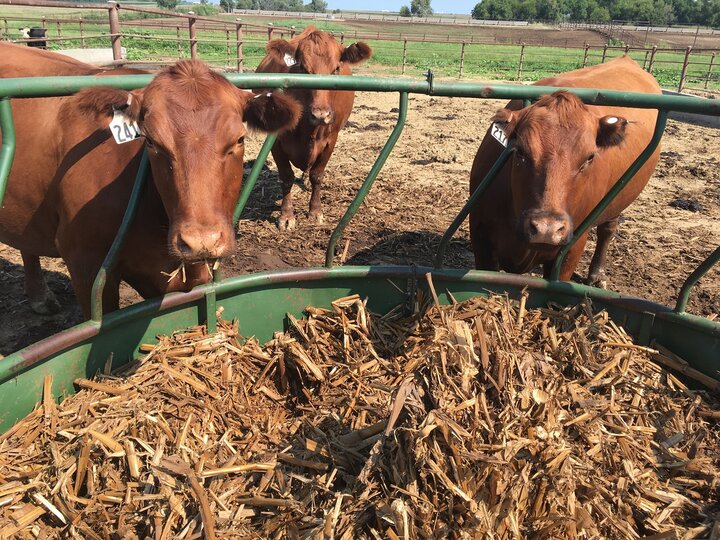Ammoniation can be used to make low quality forages, like corn residue, have digestibility and protein content that is the equivalent of, or slightly better than, grass hay.
The Process of Ammoniation
Ammoniation of corn residue is relatively easy (although working with anhydrous ammonia can be dangerous and proper safety precautions must be taken). To ammoniate residue, the bales will be stacked together and the outside covered with plastic.
To prepare an area to ammoniate the bales, set aside a spot that will accommodate the stack of bales plus an additional 5 to 6 feet around all four sides. Scrape the ground and push the dirt to the sides of the area where the bales will be stacked. The dirt will be used to seal the plastic covering the stack around the edges.
Gather bales into stacked rows. If using round bales, stack in a pyramid (i.e. three bales on the base, two bales on the second level) leaving a couple of inches between pyramids for the ammonia to filter around the bales.
Cover the entire stack with one sheet of 6 to 8 millimeter black plastic. If the plastic is 40 x 100 ft, you will be able to cover 10-12 pyramids in a row. Make sure the edges of plastic on the ground are sealed with the loose soil to prevent leaking of ammonia. Any holes in the plastic should be patched using duct-tape to prevent loss of ammonia.
How to Calculate How Much Anhydrous You Need
If the stack was arranged in pyramids (3 bale base, 2 bales on top) 14 bales long, there would be a total of 84 bales. Assuming each bale weighed 1200 pounds, there would be 50.4 tons of residue. If the residue was 90% dry matter, there would be 42.8 tons (50.4 tons x 0.85 = 42.8 tons) of dry matter (DM). You will want to add 60 pounds of anhydrous ammonia per ton of dry forage (3 %). For this example, 2,724 pounds of anhydrous ammonia (42.8 tons DM x 60lbs = 2,568 lbs.) would be needed.
Remember, the ammoniation process is temperature dependent and occurs faster at higher environmental temperatures. This is why ammoniation of straw harvested in the summer works so well. However, this does not mean that it can’t be done successfully even in late fall after corn residue is harvested. Corn residue has been successfully ammoniated starting in early November. When ammoniating during cooler ambient temperature, the key is to leave the stack sealed longer. At a temperature of 86° F or higher, leave the stack sealed for 7 days. At temperatures of 60° to 86° F, leave it sealed for 2 to 4 weeks. When temperatures are below 60° F, keep it sealed for 4 to 8 weeks. Black plastic is recommended, as it collects heat from the sun and will make the temperature in the stack warmer than ambient temperature, helping the reaction. It is a good practice to open the plastic and let the stack breath for 24 hours before feeding.
Determining the Cost of Ammoniation
Anhydrous ammonia priced at $500 per ton would be $0.25 per pound. It is suggested that you use 60 pounds of anhydrous per ton of DRY MATTER. If your residue was 85% DM, you would need to add 51 pounds of anhydrous per ton of residue, therefore, the cost of the anhydrous would be $13 per ton (as-fed). The plastic will cost about $7 per ton, and if labor was $3 per ton with machinery costs at $2 per ton, then the total ammoniation estimated cost, not including the residue, would be $25/ton. Right now, corn residue is being sold for around $60/ton, making the total cost of ammoniated residue around $85/ton.
What About Waste?
We recently conducted a study to look at waste when corn residue bales were fed to cows using a round bale feeder, similar to how hay is often fed. Conventionally harvested (raked and baled) corn residue had about 22% waste when ammoniated and fed this way. Corn residue that was harvested by turning off the spreader and baling the tailings had only 16% waste. This reduction in waste is because cobs appear to respond well to ammoniation and are much more palatable after being treated.
Using the same type of hay feeders, bale waste for grass hay would be around 14%. So, the price of ammoniated conventional residue consumed would be $104/ton or $120/ton of DM (again assuming 85% DM). If medium quality hay was $95/ton, the price of the hay consumed would be $108/ton, and at 88% DM, this would equal $122/ton of DM.
What is the Feeding Value?
The energy content of ammoniated corn residue is around 55% TDN and the crude protein is about 9%. That is equivalent to, if not better than, “fair to good” grass hay. Given current anhydrous ammonia prices, if corn residue can be purchased for $34 ton less than the price of grass hay, you may want to consider ammoniating corn residue.
Final Thoughts
Ammoniation can transform baled corn residue into forage that meets the energy and protein needs of a dry cow without supplementation. The value of ammoniation will depend on the availability and cost of other forages and the cost of anhydrous ammonia. Remember anhydrous ammonia can be dangerous and proper safety precautions must be taken.
To find out more about ammoniation check out: EC89-265. Ammonia Treatment of Low Quality Forages.
Interviews with the authors of BeefWatch newsletter articles become available throughout the month of publication and are accessible at https://go.unl.edu/podcast.
Topics covered:
Crop residues, Forages, Harvested feeds, Hay, Corn, Nutrition

